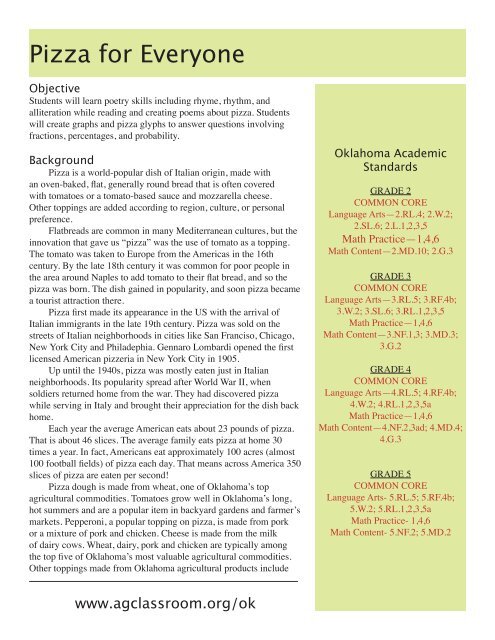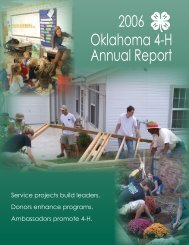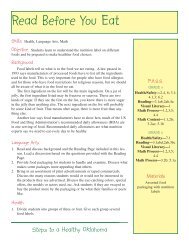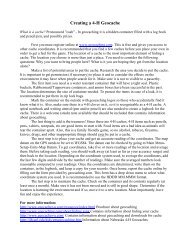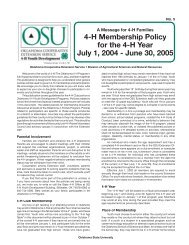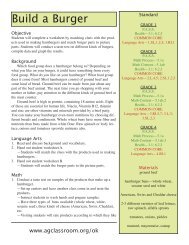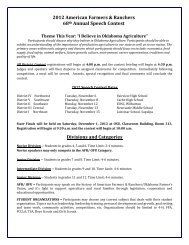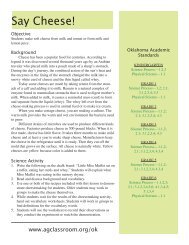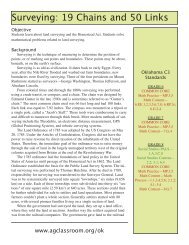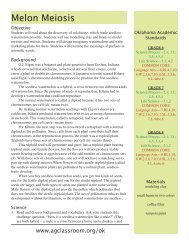Pizza for Everyone - Oklahoma 4-H
Pizza for Everyone - Oklahoma 4-H
Pizza for Everyone - Oklahoma 4-H
You also want an ePaper? Increase the reach of your titles
YUMPU automatically turns print PDFs into web optimized ePapers that Google loves.
<strong>Pizza</strong> <strong>for</strong> <strong>Everyone</strong><br />
Objective<br />
Students will learn poetry skills including rhyme, rhythm, and<br />
alliteration while reading and creating poems about pizza. Students<br />
will create graphs and pizza glyphs to answer questions involving<br />
fractions, percentages, and probability.<br />
Background<br />
<strong>Pizza</strong> is a world-popular dish of Italian origin, made with<br />
an oven-baked, flat, generally round bread that is often covered<br />
with tomatoes or a tomato-based sauce and mozzarella cheese.<br />
Other toppings are added according to region, culture, or personal<br />
preference.<br />
Flatbreads are common in many Mediterranean cultures, but the<br />
innovation that gave us “pizza” was the use of tomato as a topping.<br />
The tomato was taken to Europe from the Americas in the 16th<br />
century. By the late 18th century it was common <strong>for</strong> poor people in<br />
the area around Naples to add tomato to their flat bread, and so the<br />
pizza was born. The dish gained in popularity, and soon pizza became<br />
a tourist attraction there.<br />
<strong>Pizza</strong> first made its appearance in the US with the arrival of<br />
Italian immigrants in the late 19th century. <strong>Pizza</strong> was sold on the<br />
streets of Italian neighborhoods in cities like San Franciso, Chicago,<br />
New York City and Philadephia. Gennaro Lombardi opened the first<br />
licensed American pizzeria in New York City in 1905.<br />
Up until the 1940s, pizza was mostly eaten just in Italian<br />
neighborhoods. Its popularity spread after World War II, when<br />
soldiers returned home from the war. They had discovered pizza<br />
while serving in Italy and brought their appreciation <strong>for</strong> the dish back<br />
home.<br />
Each year the average American eats about 23 pounds of pizza.<br />
That is about 46 slices. The average family eats pizza at home 30<br />
times a year. In fact, Americans eat approximately 100 acres (almost<br />
100 football fields) of pizza each day. That means across America 350<br />
slices of pizza are eaten per second!<br />
<strong>Pizza</strong> dough is made from wheat, one of <strong>Oklahoma</strong>’s top<br />
agricultural commodities. Tomatoes grow well in <strong>Oklahoma</strong>’s long,<br />
hot summers and are a popular item in backyard gardens and farmer’s<br />
markets. Pepperoni, a popular topping on pizza, is made from pork<br />
or a mixture of pork and chicken. Cheese is made from the milk<br />
of dairy cows. Wheat, dairy, pork and chicken are typically among<br />
the top five of <strong>Oklahoma</strong>’s most valuable agricultural commodities.<br />
Other toppings made from <strong>Oklahoma</strong> agricultural products include<br />
<strong>Oklahoma</strong> Academic<br />
Standards<br />
GRADE 2<br />
COMMON CORE<br />
Language Arts—2.RL.4; 2.W.2;<br />
2.SL.6; 2.L.1,2,3,5<br />
Math Practice—1,4,6<br />
Math Content—2.MD.10; 2.G.3<br />
GRADE 3<br />
COMMON CORE<br />
Language Arts—3.RL.5; 3.RF.4b;<br />
3.W.2; 3.SL.6; 3.RL.1,2,3,5<br />
Math Practice—1,4,6<br />
Math Content—3.NF.1,3; 3.MD.3;<br />
3.G.2<br />
GRADE 4<br />
COMMON CORE<br />
Language Arts—4.RL.5; 4.RF.4b;<br />
4.W.2; 4.RL.1,2,3,5a<br />
Math Practice—1,4,6<br />
Math Content—4.NF.2,3ad; 4.MD.4;<br />
4.G.3<br />
GRADE 5<br />
COMMON CORE<br />
Language Arts- 5.RL.5; 5.RF.4b;<br />
5.W.2; 5.RL.1,2,3,5a<br />
Math Practice- 1,4,6<br />
Math Content- 5.NF.2; 5.MD.2<br />
www.agclassroom.org/ok
hamburger, from beef cows, another top <strong>Oklahoma</strong> commodity.<br />
<strong>Pizza</strong> can be high in salt and saturated fat, but it doesn’t have to be.<br />
Classic Neapolotian pizza is made with just fresh tomatoes, a moderate<br />
amount of mozzarella cheese and basil leaves, all healthy ingredients.<br />
A variety of fruits and vegetables can be added to pizza to make it more<br />
nutritious.<br />
Materials<br />
paper plates<br />
tempera paint or markers<br />
Just <strong>for</strong> Fun: Broccoli<br />
Trees<br />
(per five students)<br />
1⁄4 cup light sour cream<br />
1⁄3 cup mayonnaise<br />
1⁄2 teaspoon sugar<br />
1 tablespoon lemon juice<br />
1 tablespoon finely chopped fresh<br />
spinach, basil or other fresh or<br />
dried herb<br />
4 carrots<br />
3 cups broccoli florets<br />
paper plates<br />
1. Prepare a dip by combining<br />
the sour cream, mayo, lemon<br />
juice and spinach or herb in a<br />
medium size mixing bowl.<br />
2. To make the trees, cut each<br />
carrot in half widthwise and<br />
then lengthwise into four<br />
pieces.<br />
3. Assemble the trees on the<br />
plates by laying three carrot<br />
pieces side by side <strong>for</strong> a trunk<br />
and placing the broccoli<br />
florets to look like leaves.<br />
Spread dip under the trunks<br />
to serve as the <strong>for</strong>est floor.<br />
Activities<br />
ACTIVITY ONE: READ AND DISCUSS<br />
1. Read and discuss the background and vocabulary about pizza.<br />
2. Hand out copies of the poem, “A <strong>Pizza</strong> the Size of the Sun,” included<br />
with this lesson.<br />
—Students will pair up to take turns reading the poem aloud.<br />
—Students will group and classify the collected data.<br />
—Students will make up motions to go with the poem as they read.<br />
—Students will tap out the poem’s rhythm.<br />
—Discuss the poem as a class, using the questions provided with the<br />
poem.<br />
—Students will make a list of rhyming words related to pizza and the<br />
farm.<br />
—Students will write their own poems, beginning with “I’m making a<br />
pizza, as ________ as a _________ .<br />
ACTIVITY TWO: PIZZA TOPPINGS AND GOOD NUTRITION<br />
1. Review the USDA MyPlate guidelines, available online: http://www.<br />
choosemyplate.gov/<br />
2. Students will brainstorm and web the different types of pizza toppings.<br />
3. Provide copies of the MyPlate guidelines, included with this lesson.<br />
Students will work individually or in groups and design their own pizza/<br />
plates to place the toppings in the correct portion of the pizza, based on<br />
the MyPlate guidelines.<br />
4. Students will explain their pizza/plates to the class.<br />
5. Students will take a classroom poll to determine favorite pizza toppings.<br />
—Students will tally classroom results.<br />
—Students will construct pictographs to show the results, using circleshaped<br />
construction paper to represent students.<br />
—Students will use their pictographs to explain the poll results.<br />
6. Students will make predictions about the school’s favorite pizza<br />
toppings and explain their predictions.<br />
—Students will work in pairs to conduct a schoolwide survey of the<br />
school’s favorite pizza topping.<br />
—Students will use calculators to compute the results of the survey.<br />
—Students will organize the data from the survey to construct a bar<br />
graph representing schoolwide results. The bar graph will be constructed<br />
on butcher paper and displayed in the hall outside the classroom.<br />
—Students will take turns explaining the graph to visitors.<br />
www.agclassroom.org/ok
ACTIVITY THREE: WRITE A PERSUASIVE LETTER<br />
1. Students will use the data collected from the schoolwide survey and write a<br />
letter to the principal persuading him/her to have a school-wide pizza party.<br />
—Remind students to keep in mind the <strong>for</strong>mat, audience, topic and<br />
purpose.<br />
—Students will check their work <strong>for</strong> correct capitalization, punctuation,<br />
spelling and language usage.<br />
ACTIVITY FOUR: PIZZA GLYPHS<br />
A glyph is a non-standard way to graph a variety of in<strong>for</strong>mation to tell a story.<br />
It uses symbols to represent data. Glyphs show several pieces of data at once<br />
and require a legend <strong>for</strong> understanding.<br />
1. Be<strong>for</strong>e students create their pizza glyph, model a live glyph.<br />
2. Write the following legend on the chalkboard:<br />
likes pizza=touching hair; dislikes pizza=hands at side<br />
likes pepperoni=tongue sticking out; dislikes pepperoni-=smile<br />
3. Ask <strong>for</strong> five or six volunteers to come to the front of the class and line up in<br />
a straight row facing the other students.<br />
4. Instruct the volunteers to touch their hair if they like pizza and to keep their<br />
hands at their sides if they do not like pizza.<br />
5. Instruct the volunteers to stick out their tongues if they like pepperoni pizza<br />
and smile if they prefer another kind.<br />
6. The volunteers will hold their positions while the teacher asks the class the<br />
following questions.<br />
—What percentage of students like pizza?<br />
—What percentage of students dislike pizza?<br />
—What percentage of students like pepperoni?<br />
—What percentage of students prefer another kind of pizza.<br />
7. Students will use the legend on the chalkboard and the living glyphs to<br />
answer the questions.<br />
8. Repeat the activity with different students and different questions and<br />
actions until all students have participated.<br />
9. Students will construct pizza glyphs on paper with symbols <strong>for</strong> favorite<br />
pizza meat topping, favorite pizza vegetable topping, favorite kind of crust<br />
(thin or thick), favorite drink, etc.<br />
10. Display the glyphs, and ask students to answer questions, based on their<br />
classmates’ glyphs.<br />
11. Students will write three sentences that best summarize the in<strong>for</strong>mation<br />
found on their classmates’ pizza glyphs.<br />
Materials<br />
construction paper<br />
pizza sauce<br />
grated cheese<br />
large tortillas<br />
ACTIVITY FIVE: PAINT A PIZZA ON A PLATE<br />
1. Provide paper plates and tempera paint or markers.<br />
2. Students will paint pizza on paper plates—brown on the edge and red in the<br />
middle.<br />
3. Students will glue construction paper circles, pipe cleaners and pom poms<br />
on the pizza to represent toppings.<br />
4. Students will cut their pizzas into slices to represent fractions. Students<br />
can divide the pizza into slices to represent the numer of people in their<br />
family or you can give them the number of slices to create. Use the slices to<br />
practice recognizing fractions, adding and subtracting fractions.
ACTIVITY SIX: MAKE A PIZZA<br />
1. Students will follow the sequential directions <strong>for</strong> making a pizza included<br />
with this lesson.<br />
2. Students will compute the amount of ingredents needed to double the<br />
recipe.<br />
Vocabulary<br />
common—familiar<br />
culture—the characteristic<br />
features of everyday life<br />
shared by people in a<br />
particular place or time<br />
immigrant—a person who<br />
comes to a country to live<br />
there<br />
innovation—the introduction<br />
of something new<br />
moderate—neither very<br />
much nor very little<br />
mozzarella—a moist white<br />
rubbery mild-flavored cheese<br />
that is much used in Italian<br />
cooking<br />
origin—a rising, beginning,<br />
or coming from a source<br />
pizza—a dish made typically<br />
of thinly rolled bread dough<br />
spread with a spiced mixture<br />
usually including tomatoes<br />
and cheese and often other<br />
toppings and baked<br />
pizzeria—an establishment<br />
where pizzas are made or<br />
sold<br />
preference—favorite<br />
region—an area, division, or<br />
district of administration<br />
Extra Reading<br />
Auch, Mary Jane, and Herm Auch, The Princess and the <strong>Pizza</strong>, Holiday<br />
House, 2003.<br />
Castaldo, Nancy, <strong>Pizza</strong> <strong>for</strong> the Queen, Holiday House, 2005.<br />
Dobson, Christina, <strong>Pizza</strong> Counting, Charlesbridge, 2003.<br />
Prelutsky, Jack, <strong>Pizza</strong>, Pigs and Poetry: How to Write a Poem, Greenwillow,<br />
2008.<br />
Prelutsky, Jack and Arthur Stevenson, A <strong>Pizza</strong> the Size of the Sun,<br />
Greenwillow, 1996.<br />
Wagner, Lisa, Cool <strong>Pizza</strong> to Make and Bake (Cool Cooking), Abdo, 2007.<br />
Watt, Fiona, and Kim Lane, and Howard Allman, Pasta & <strong>Pizza</strong> <strong>for</strong> Beginners<br />
(Usborne Cooking School), EDC, 2003.<br />
Wellington, Monica, <strong>Pizza</strong> at Sally’s, Dutton Juvenile, 2006.<br />
Worley, Rob M., The <strong>Pizza</strong> Mystery (Boxcar Children Graphic Novels), Albert<br />
Whitman, 2010 (reprint).
Reading Page<br />
A <strong>Pizza</strong> the Size of the Sun<br />
I’m making a pizza the size of the sun,<br />
a pizza that’s sure to weigh more than a ton,<br />
a pizza too massive to pick up and toss,<br />
a pizza resplendent with oceans of sauce.<br />
Vocabulary<br />
I’m topping my pizza with mountains of cheese,<br />
with acres of peppers, pimentos, and peas,<br />
with mushrooms, tomatoes, and sausage galore,<br />
with every last olive they had at the store.<br />
My pizza is sure to be one of a kind,<br />
my pizza will leave other pizzas behind,<br />
my pizza will be a delectable treat<br />
that all who love pizza are welcome to eat.<br />
massive<br />
delectable<br />
resplendent<br />
1. Which word means “so bright it seems to<br />
glow?”<br />
2. Which word means “heavy?”<br />
3. Which word means “delicious?”<br />
The oven is hot, I believe it will take<br />
a year and a half <strong>for</strong> my pizza to bake.<br />
I hardly can wait till my pizza is done,<br />
my wonderful pizza the size of the sun.<br />
from Prelutsky, Jack and Arthur Stevenson, A <strong>Pizza</strong> the Size of the Sun, Greenwillow, 1996.<br />
DISCUSSION QUESTIONS<br />
1. How is a pizza like the sun?<br />
2. What pictures does the poem make you see? Which words help you see these pictures?<br />
3. Circle the rhyming words.<br />
4. Find an example of alliteration and underline it.<br />
5. How does the author express the idea of a large number of olives?<br />
6. Why will the pizza take a year and a half to bake?<br />
7. What is the poet’s purpose in writing this poem?<br />
8. Read the poem aloud and tap out the rhythm.<br />
9. Make up motions to do while you read the poem.<br />
10. Draw a picture to illustrate the poem.<br />
<strong>Oklahoma</strong> Ag in the Classroom is a program of the <strong>Oklahoma</strong> Cooperative Extension Service, the <strong>Oklahoma</strong><br />
Department of Agriculture, Food and Forestry and the <strong>Oklahoma</strong> State Department of Education.
Name_____________________________________________________________________________________<br />
<strong>Pizza</strong> <strong>for</strong> <strong>Everyone</strong><br />
<strong>Pizza</strong><br />
Serves six<br />
2 cups pizza sauce<br />
1 cup grated cheese<br />
1 large tortilla<br />
Preheat the oven to 425 degrees.<br />
Spread the pizza sauce on the tortilla.<br />
Sprinkle the cheese over the pizza sauce.<br />
Place the pizza in the oven.<br />
Cook <strong>for</strong> 12-14 minutes.<br />
Remove the pizza from the oven and let it cool be<strong>for</strong>e serving.<br />
This recipe makes enough <strong>for</strong> six people. You need to make enough <strong>for</strong> 12 people.<br />
How much of each ingredient do you need? Explain your answer.<br />
<strong>Oklahoma</strong> Ag in the Classroom is a program of the <strong>Oklahoma</strong> Cooperative Extension Service, the <strong>Oklahoma</strong><br />
Department of Agriculture, Food and Forestry and the <strong>Oklahoma</strong> State Department of Education.
Name_____________________________________________________________________________________<br />
Choose My Plate<br />
<strong>Oklahoma</strong> Ag in the Classroom is a program of the <strong>Oklahoma</strong> Cooperative Extension Service, the <strong>Oklahoma</strong><br />
Department of Agriculture, Food and Forestry and the <strong>Oklahoma</strong> State Department of Education.


